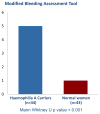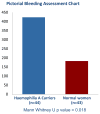A cross-sectional study of bleeding phenotype in haemophilia A carriers
- PMID: 25832012
- PMCID: PMC4490107
- DOI: 10.1111/bjh.13423
A cross-sectional study of bleeding phenotype in haemophilia A carriers
Abstract
Haemophilia A carriers have historically been thought to exhibit normal haemostasis. However, recent data demonstrates that, despite normal factor VIII (FVIII), haemophilia A carriers demonstrate an increased bleeding tendency. We tested the hypothesis that obligate haemophilia carriers exhibit an increase in clinically relevant bleeding. A cross-sectional study was performed comparing haemophilia A carriers to normal women. Questionnaire assessment included a general bleeding questionnaire, condensed MCMDM-1VWD bleeding assessment tool and Pictorial Bleeding Assessment Chart (PBAC). Laboratory assessment included complete blood count, prothrombin time, activated partial thromboplastin time, fibrinogen activity, FVIII activity (
Fviii: C), von Willebrand factor antigen level, ristocetin cofactor, platelet function analyser-100(TM) and ABO blood type. Forty-four haemophilia A carriers and 43 controls were included. Demographic features were similar. Laboratory results demonstrated a statistically significant difference only in
Fviii: C (82·5 vs. 134%, P < 0·001). Carriers reported a higher number of bleeding events, and both condensed MCMDM-1 VWD bleeding scores (5 vs. 1, P < 0·001) and PBAC scores (423 vs. 182·5, P = 0·018) were significantly higher in carriers. Haemophilia A carriers exhibit increased bleeding symptoms when compared to normal women. Further studies are necessary to fully understand the bleeding phenotype in this population and optimize clinical management.
Keywords: coagulation; factor VIII; haemophilia; haemostasis.
© 2015 John Wiley & Sons Ltd.
Conflict of interest statement
Figures




Similar articles
-
Clotting factor level is not a good predictor of bleeding in carriers of haemophilia A and B.Blood Coagul Fibrinolysis. 2014 Jul;25(5):471-5. doi: 10.1097/MBC.0000000000000083. Blood Coagul Fibrinolysis. 2014. PMID: 24509327
-
Determinants of factor VIII plasma levels in carriers of haemophilia A and in control women.Haemophilia. 2010 Jan;16(1):111-7. doi: 10.1111/j.1365-2516.2009.02108.x. Epub 2009 Sep 16. Haemophilia. 2010. PMID: 19758307
-
Haemophilia A carriers experience reduced health-related quality of life.Haemophilia. 2015 Nov;21(6):761-5. doi: 10.1111/hae.12690. Epub 2015 Apr 30. Haemophilia. 2015. PMID: 25930174 Free PMC article.
-
Factor VIII: Long-established role in haemophilia A and emerging evidence beyond haemostasis.Blood Rev. 2019 May;35:43-50. doi: 10.1016/j.blre.2019.03.002. Epub 2019 Mar 3. Blood Rev. 2019. PMID: 30922616 Review.
-
Regulation and importance of factor VIII levels in hemophilia A carriers.Curr Opin Hematol. 2021 Sep 1;28(5):315-322. doi: 10.1097/MOH.0000000000000667. Curr Opin Hematol. 2021. PMID: 34397591 Review.
Cited by
-
A Novel Deletion Mutation of the F8 Gene for Hemophilia A.Diagnostics (Basel). 2022 Nov 21;12(11):2876. doi: 10.3390/diagnostics12112876. Diagnostics (Basel). 2022. PMID: 36428936 Free PMC article.
-
Managing Pregnant Women with Hemophilia and von Willebrand Disease: How Do We Provide Optimum Care and Prevent Complications?Int J Womens Health. 2022 Sep 12;14:1307-1313. doi: 10.2147/IJWH.S273043. eCollection 2022. Int J Womens Health. 2022. PMID: 36119805 Free PMC article. Review.
-
A qualitative study on the experiences of haemophilia carriers before, during and after pregnancy.Haemophilia. 2021 Nov;27(6):e675-e682. doi: 10.1111/hae.14396. Epub 2021 Aug 20. Haemophilia. 2021. PMID: 34415675 Free PMC article.
-
Sexism in the management of bleeding disorders.Res Pract Thromb Haemost. 2020 Dec 13;5(1):51-54. doi: 10.1002/rth2.12468. eCollection 2021 Jan. Res Pract Thromb Haemost. 2020. PMID: 33537529 Free PMC article.
-
Association of factor expression levels with annual bleeding rate in people with haemophilia B.Haemophilia. 2023 Jan;29(1):115-122. doi: 10.1111/hae.14675. Epub 2022 Nov 4. Haemophilia. 2023. PMID: 36331904 Free PMC article.
References
-
- Azzam HA, Goneim HR, El-Saddik AM, Azmy E, Hassan M, El Sharawy S. The condensed MCMDM-1 VWD bleeding questionnaire as a predictor of bleeding disorders in women with unexplained menorrhagia. Blood Coagulation Fibrinolysis. 2012;23(4):311–5. - PubMed
-
- Graham JB, Rizza CR, Chediak J, Mannucci PM, Briet E, Ljung R, et al. Carrier detection in Haemophilia A: a cooperative international study. I. The carrier phenotype. Blood. 1986;67(6):1554–9. - PubMed
-
- Higham JM, O’Brien PMS, Shaw RW. Assessment of menstrual blood loss using a pictorial chart. British Journal of Obstetrics and Gynecology. 1990;97:734–739. - PubMed
-
- Lee C, Berntorp EA, Hoots WK. Textbook Of Haemophilia. 2. Oxford, UK: Wiley-Blackwell; 2010.
Publication types
MeSH terms
Grants and funding
LinkOut - more resources
Full Text Sources
Other Literature Sources
Medical

